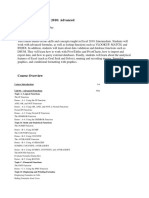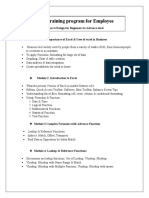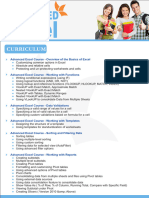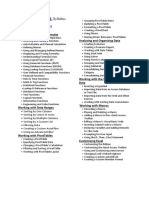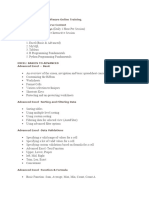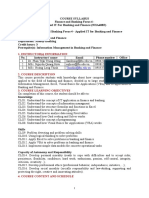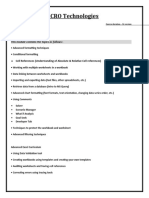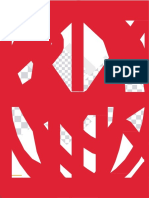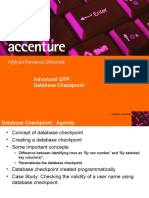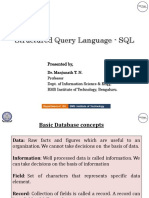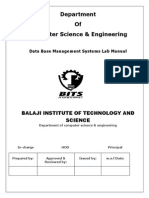Diploma in Data Science
Topic - 1 Advanced Excel With VBA
Topic - 2 SQL (Structured Query Language)
Topic - 3 Data Analytics Using R Programing
Topic - 4 Python Programming
Topic - 5 Advanced Python Programing
Topic - 6 SPSS (Statistical Package for Social Science)
Topic - 7 Tableau
1
� Advanced Excel with VBA
Module – 01 : Basic Course – Basic Formula, Functions & Charts
Formulas and Functions
Formula Tab
Examples of Formulas
Auto Sum Features
Formula
Charts
Smart Art Graphics
Module – 02 : Advanced Functions in Excel
Introduction
If Statements
Nesting IF()’s
Using Other Functions with IF’s
Concatenation
LookUp Functions(VLOOKUP & HLOOKUP)
Subtotals
Hiding & Displaying Data
Module – 03 : Data Validations
Introduction
Setting Data Validations
Data Validation
Checking for Invalid Data
Module – 04 : Excels Analytical Tools
Goal Seek
Scenarios
Summarizing Scenarios
Creating a Scenario Pivot Table Report
Module – 05 : Pivot Table
Using Pivot Tables to analyze data
Pivoting
Pivot Table Example
Guidelines for creating a Pivot Table in Excel
Creating a Pivot Table
2
�Module – 06 : Introduction to VBA
Introduction to VBA
Work with VBA objects, properties, methods
Working with the Visual Basic Editor
Sub procedure, function procedure, property procedure
Referring to Objects
Concepts – Containers or Collections, properties, methods, events,
Working with Workbook
Referring to Objects
Applying Methods
Working with Variables and Values
Module – 07 : Working with Variables in Excel VBA
Concept of Variables
Valid and invalid variable names
Variables - Numeric Data Types
Variables – Non - Numeric Data Types
Module – 08 : Message Box & Loop
Style Values and Command Buttons
Return Values and Command Buttons
Looping
For...Next loop
Do.......Loop While
Do until.............Loop
Do while.......... Loop
Do...........Loop until
Module – 09 : Array in Excel VBA
What is an Array?
Declaring Arrays in Excel VBA
One Dimensional Array
Two Dimensional Array
Module – 10 : Developing Macros in Excel
Creating a Macro
Excel Macro Recording facility
Modifying the existing Macro in VB editor
Understanding the Macro and saving a workbook with Macro contents
Exporting files to different applications
3
�Module – 11 : UserForm
Requirement of UserForm
Working with objects like textboxes, buttons, check boxes, spin buttons etc.
Filling up UserForm with pre-defined values
Macro Coding for different buttons
Creating Connectivity between UserForm and Excel Worksheet
Module – 12 : UserForm (Cont’d)
Designing UserForm with Validations
Filling up UserForm with pre-defined values
Creating Connectivity between UserForm and Excel Worksheet using offset
Transfer of data from excel file to a word document
Transfer of data from txt file to an excel document
4
� SQL (Structured Query Language)
Introduction to DBMS
File Management System And Its Drawbacks
Database Management System (DBMS) and Data Models
Physical Data Models
Logical Data Models
Hierarchical Data Model (HDBMS)
Network Data Model (NDBMS)
Relational Data Model (RDBMS)
Object Data Model (ODBMS)
Object Relational Data Model (ORDBMS)
Conceptual Data Models
Entity – Relationship (E-R) Model
Introduction to SQL Server
Advantages and Drawbacks Of SQL Server
Connecting To Server
Server Type
Server Name
Authentication Modes
Sql Server Authentication Mode
Windows Authentication Mode
Login and Password
Sql Server Management Studio and Tools In Management Studio
Object Explorer
Object Explorer Details
Query Editor
TSQL (Transact-Structured Query Language)
Introduction to TSQL
History and Features of TSQL
Types Of TSQL Commands
Data Definition Language (DDL)
Data Manipulation Language (DML)
Data Query Language (DQL)
Data Control Language (DCL)
Transaction Control Language (TCL)
5
�Database
Creating Database
Altering Database
Deleting Database
Constrains
Procedural Integrity Constraints
Declarative Integrity Constraints
Not Null, Unique, Default and Check constraints
Primary Key and Referential Integrity or foreign key constraints
Data Types In TSQL
Table
Creating Table
Altering Table
Deleting Table
Data Manipulation Language
Insert
Identity
Creating a Table from another Table
Inserting Rows from One Table to Another
Update
Computed Columns
Delete
Truncate
Differences Between Delete and Truncate
Data Query Language (DQL)
Select
Where clause
Order By Clause
Distinct Keyword
Isnull() function
Column aliases
Predicates
Between … And
In
Like
Is Null
6
�Top n Clause
Set Operators
Union
Intersect
Except
Joins
Inner Join
Equi Join
Natural Join
Non-Equi Join
Self Join
Outer Join
Left Outer Join
Right Outer Join
Full Outer Join
Cross Join
Sub Queries
Single Row Sub Queries
Multi Row Sub Queries
Any or Some
ALL
Nested Sub Queries
Co-Related Sub Queries
Exists and Not Exists
Indexes
Clustered Index
Non Clustered Index
Create, Alter and Drop Indexes
Using Indexes
Stored Sub Programs
Advantages Of Stored Sub Programs compared to Independent SQL Statements
Stored Procedures
Creating , Altering and Dropping
Optional Parameters
Input and Output Parameters
Permissions on Stored Procedures
User Defined Functions
Creating, Altering and Dropping
Types Of User Defined Functions
7
� Scalar Functions
Table Valued Functions
Inline Table Valued Functions
Multi Statement Table Valued Functions
Permissions On User Defined Functions
Triggers
Purpose of Triggers
Differences Between Stored Procedures and User Defined Functions and Triggers
Creating, Altering and Dropping Triggers
Magic Tables
Instead Of Triggers
Exception Handling
Implementing Exception Handling
Adding and removing User Defined Error Messages To And From SQL Server Error Messages
List
8
� Data Analytics Using R Programming
Exploring R
Installing R
Working with Scripts
Navigating the Workspace
Reading Datasets into R, Exporting Data from R
Using C() command to create Data
Using scan() command for getting Data in R
Reading Bigger Data files
Getting data out of R
Saving your work in R
Manipulating and Processing Data in R
Deciding most appropriate data structure
Creating subset of data
Adding calculated fields to data
Combining and merging datasets in R
Sorting and ordering Data
Introduction to the formula interface
Putting your data into Shape
Using Functions and Packages in R
Moving from Scripts to Functions
Using Argument the smart way
Scope of the function
Dispatching to a Method
Packages
Using Packages
Descriptive Statistics in R
Summary Commands
Name Commands
Summarizing Samples
Cumulative Statistics
Summary Statistics for Data Frames
Summary Statistics for Matrix Objects
Summary Statistics for Lists
Contingency Tables
Cross Tabulation
9
�Analyzing Data Using Functions, Loops, and Data Frames
Matrices, Lists, and Data Frames
Indexing vectors, Matrices, and Lists
Programming in R
Graphical Analysis in R
Plots for single variable
Plots with two variables
Plots with multiple Comparisons
Plots with multiple Variables
Special plots
Saving Graphs to External Files
Hypotheses Testing in R
Introduction to Statistical Hypotheses
Using the student’s t-test
U-test
Paired t- and u-test
Tests for Association
Goodness of Fit Tests
Linear Regression in R
Basics of Linear Regression Analysis
Working with Linear Regression
Simple Linear Regression in R
Linear Model result Objects
Using R Commander Package
10
� Python Programming
OVERVIEW
History of Python
Python Features
Environment Setup
Getting Python installing Python
Setting up PATH
Setting path at Windows
Python Environment Variables
Running Python
BASIC SYNTAX
Python Program
Python Identifiers
Python Keywords
Lines and Indentation
Multi-Line Statements
Quotation in Python
Python Comments in Python
Multiple Statements on a Single Line
Command Line Arguments
Accessing Command-Line Arguments
Parsing Command-Line Arguments
VARIABLE TYPES
Assigning Values to Variables
Multiple Assignment
Standard Data Types
Python Numbers
Python Strings
Python Lists
Data Type Conversion
11
�BASIC OPERATORS
Types of Operators
Arithmetic Operators
Comparison Operators
Logical Operators
DECISION MAKING
If…else Statement
The elif Statement
Single Statement Suites
LOOPS While Loop
The Infinite Loop
Using else Statement with Loops
Single Statement Suites
For Loop
Break Statement
Continue Statement
FUNCTIONS
Defining a Function
Calling a Function
Passing by Reference Vs Passing by Value
Global vs. Local variables
Locating Modules
Packages in Python
FILES I/O
Printing to the Screen
Reading Keyboard Input
The raw_input Function
The input Function
Opening and Closing Files
The open Function
The file Object Attributes
The close() Method
Reading and Writing Files
The write() Method
The read() Method
12
�EXCEPTIONS
What is Exception
Handling an Exception
The except Clause with No Exceptions
The except Clause with Multiple Exceptions
The try-finally Clause
Argument of an Exception
Raising an Exception
User-Defined Exceptions
CLASSES AND OBJECTS
Overview of OOP Terminology
Creating Classes
Creating Instance
Objects
Built-In Class Attributes
Class Inheritance
Overriding Methods
Base Overloading Methods
13
� Advanced Python Programming
Operating on Data in Pandas & Missing Values
Hierarchical Indexing
Combining Datasets – Join, Merge, append etc
Aggregation & Grouping
Vectorized String Operations
Visualisation with Matplotlab
Analysing Data Through Advanced Visualisation
Inferential Statistics
Designing Models with Linear Regression
Designing Models with Logistic Regression
Hypothesis Checking
K-Means Clustering
14
� SPSS (Statistical Package for Social Science)
Introducing to SPSS
SPSS - Introduction
The interface
The variable view
The data view
The output view
The syntax view
Reading Data from various Sources
Reading Data from a Text file
Reading Data from a Database
Reading Data from Excel Sheets
Reading SPSS Data Files
Variables & Dataset Creation
Naming of Variable names
Creating Labels for Variables
Variables Type
Binary Variables
New data set Creation
Data Transformations
Transformation of Data
Expressions creation with more than one variable
Various Conditional Expressions
Modifying Data Values
Data Values Modifications
New Variable Computation
Crosstab Report
Crosstab Statistics
Creating of Crosstab Report
Crosstab cells
Adding various layers to crosstabs
15
�Sorting and Selecting Data
Data Selection and Sorting
Split-File
Creation of Subsets of Cases
Working with Output
Working with Output
Pivot Table Editor
Using SPSS Results in Other Applications
Exporting SPSS Results to Microsoft Excel, Microsoft Word and PDF Files
Descriptive Statistics
Descriptive statistics: Descriptive (univariate)
Frequencies
Categorical Data Measurement
Categorical Data - Charts
Scale Variables – Their measurements
Recoding the existing variables
Univariate Analysis
Line Graphs
Bar Graphs
Pie Graph
Graphs for cumulative frequency
Histograms and frequency statistics – with variables
Determining the nature of the distribution of continuous variables
Boxplot
T-Test and error bar
Multivariate Analysis
Bar Graph for Means
Line graph for comparing median
Scatters
Correlations
Bivariate correlations
Partial correlations
Plotting scatters of several variables against one other
Execute the analyses for means comparison: t test, between-subjects ANOVA
Perform the regression analysis (simple and multiple regression)
Time Series
16
� Tableau
Introduction to Data Visualization
Introduction of Data Visualization using Tableau
Tableau Basics
Working with Sorting and Filters
Creating Dual Axis and Combo Charts
Table Calculations
Calculated Field
Logical Calculations
Date Calculations
Parameters
Using Actions to Create Interactive Dashboards
Advanced Charts
Working with data
Sets
Drilling Up/Down using Hierarchies
Grouping
Bins/Histograms
Analytics using Tableau
Dashboards
Story Telling with Data
Data Interpreter
17

